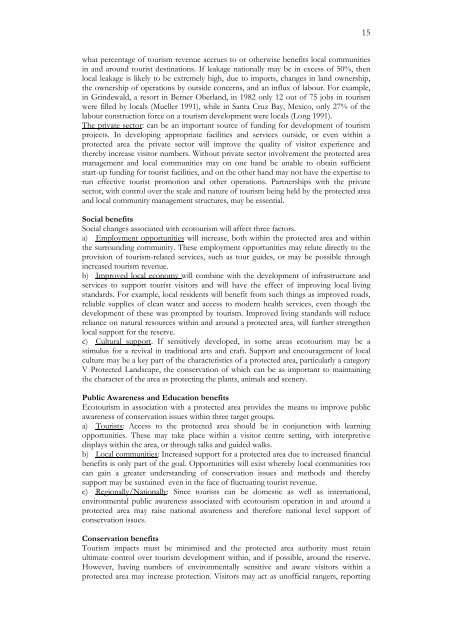The Unfenced Desert Towards a strategy for eco ... - Nwrc.gov.sa
The Unfenced Desert Towards a strategy for eco ... - Nwrc.gov.sa
The Unfenced Desert Towards a strategy for eco ... - Nwrc.gov.sa
Create successful ePaper yourself
Turn your PDF publications into a flip-book with our unique Google optimized e-Paper software.
what percentage of tourism revenue accrues to or otherwise benefits local communities<br />
in and around tourist destinations. If leakage nationally may be in excess of 50%, then<br />
local leakage is likely to be extremely high, due to imports, changes in land ownership,<br />
the ownership of operations by outside concerns, and an influx of labour. For example,<br />
in Grindewald, a resort in Berner Oberland, in 1982 only 12 out of 75 jobs in tourism<br />
were filled by locals (Mueller 1991), while in Santa Cruz Bay, Mexico, only 27% of the<br />
labour construction <strong>for</strong>ce on a tourism development were locals (Long 1991).<br />
<strong>The</strong> private sector: can be an important source of funding <strong>for</strong> development of tourism<br />
projects. In developing appropriate facilities and services outside, or even within a<br />
protected area the private sector will improve the quality of visitor experience and<br />
thereby increase visitor numbers. Without private sector involvement the protected area<br />
management and local communities may on one hand be unable to obtain sufficient<br />
start-up funding <strong>for</strong> tourist facilities, and on the other hand may not have the expertise to<br />
run effective tourist promotion and other operations. Partnerships with the private<br />
sector, with control over the scale and nature of tourism being held by the protected area<br />
and local community management structures, may be essential.<br />
Social benefits<br />
Social changes associated with <strong>eco</strong>tourism will affect three factors.<br />
a) Employment opportunities will increase, both within the protected area and within<br />
the surrounding community. <strong>The</strong>se employment opportunities may relate directly to the<br />
provision of tourism-related services, such as tour guides, or may be possible through<br />
increased tourism revenue.<br />
b) Improved local <strong>eco</strong>nomy will combine with the development of infrastructure and<br />
services to support tourist visitors and will have the effect of improving local living<br />
standards. For example, local residents will benefit from such things as improved roads,<br />
reliable supplies of clean water and access to modern health services, even though the<br />
development of these was prompted by tourism. Improved living standards will reduce<br />
reliance on natural resources within and around a protected area, will further strengthen<br />
local support <strong>for</strong> the reserve.<br />
c) Cultural support. If sensitively developed, in some areas <strong>eco</strong>tourism may be a<br />
stimulus <strong>for</strong> a revival in traditional arts and craft. Support and encouragement of local<br />
culture may be a key part of the characteristics of a protected area, particularly a category<br />
V Protected Landscape, the conservation of which can be as important to maintaining<br />
the character of the area as protecting the plants, animals and scenery.<br />
Public Awareness and Education benefits<br />
Ecotourism in association with a protected area provides the means to improve public<br />
awareness of conservation issues within three target groups.<br />
a) Tourists: Access to the protected area should be in conjunction with learning<br />
opportunities. <strong>The</strong>se may take place within a visitor centre setting, with interpretive<br />
displays within the area, or through talks and guided walks.<br />
b) Local communities: Increased support <strong>for</strong> a protected area due to increased financial<br />
benefits is only part of the goal. Opportunities will exist whereby local communities too<br />
can gain a greater understanding of conservation issues and methods and thereby<br />
support may be sustained even in the face of fluctuating tourist revenue.<br />
c) Regionally/Nationally: Since tourists can be domestic as well as international,<br />
environmental public awareness associated with <strong>eco</strong>tourism operation in and around a<br />
protected area may raise national awareness and there<strong>for</strong>e national level support of<br />
conservation issues.<br />
Conservation benefits<br />
Tourism impacts must be minimised and the protected area authority must retain<br />
ultimate control over tourism development within, and if possible, around the reserve.<br />
However, having numbers of environmentally sensitive and aware visitors within a<br />
protected area may increase protection. Visitors may act as unofficial rangers, reporting<br />
15

















